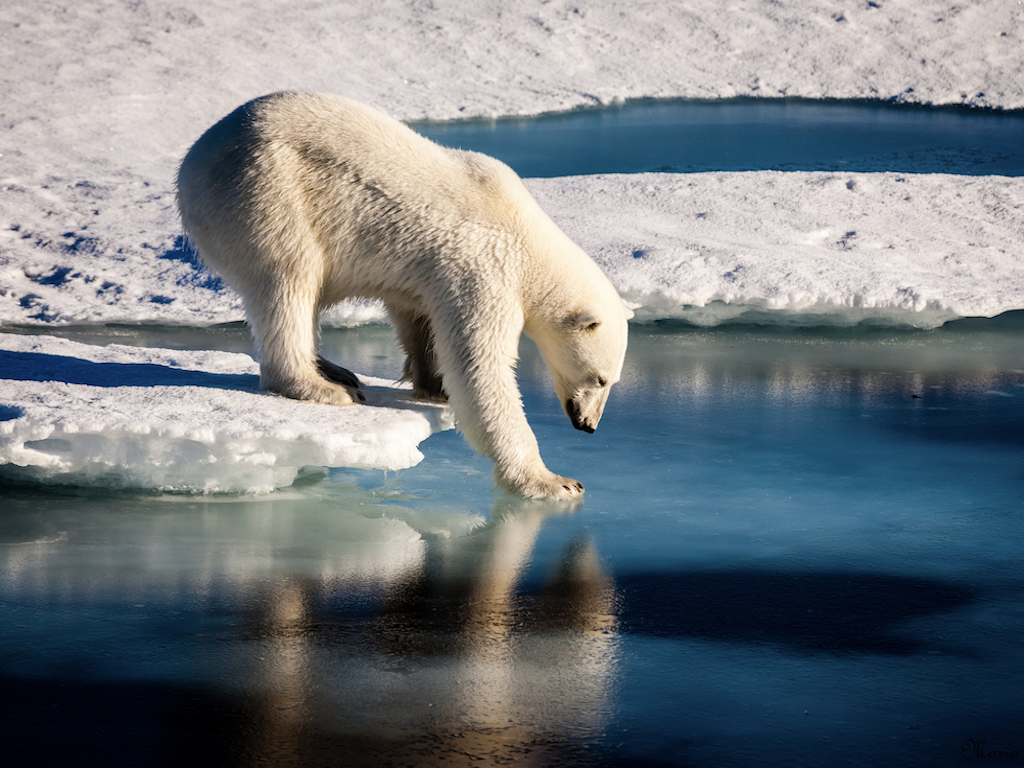4 Mins Read
By: Tim Radford
Within 30 years, there could be clear blue water over the North Pole – not good news for most of the planet.
Within three decades, the North Pole could be free of sea ice in the late summer. The latest and most advanced climate simulations, tested by 21 research institutes from around the world, predict that if humans go on emitting ever-greater volumes of carbon dioxide from fossil fuel combustion and other actions, then before 2050, for the first time in human history, there could be no ice over the North Pole.
And a team of research scientists aboard a ship intent on spending a year observing the drift of sea ice across the Arctic Ocean has been warned that they may have to finish early: the ice supposed to hold the ship fast could melt too soon.
The loss of sea ice promises devastating consequences for the rich life in the most northern waters. The ice reflects sunlight back into space and keeps the Arctic cool. It also provides space for seals on which to haul out, and hunting grounds for blubber-hungry polar bears.
And although human inaction in the climate emergency makes the loss of polar ice ever more probable, so much greenhouse gas has already built up in the planetary atmosphere that it could happen anyway.
Taken aback
“If we reduce global emissions rapidly and substantially, and thus keep our warming below 2°C relative to pre-industrial levels, sea ice will nevertheless likely disappear occasionally in summer even before 2050,” said Dirk Notz, of the University of Hamburg in Germany, who led the study. “This really surprised us.”
Climate scientists first warned of the accelerating loss of Arctic sea ice two decades ago, and have repeatedly re-examined the climate predictions, each time with much the same outcome.
The loss of ice promises new trade routes between Atlantic and Pacific Oceans, but the cost of a warming Arctic could have catastrophic economic consequences.
The pattern of the northern hemisphere climate is driven by the temperature difference between the Arctic and the tropics, and rapid polar warming both disturbs temperate climate regimes and brings ever higher sea levels, with accelerating ice loss from Greenland, which right now bears enough ice to raise global sea levels by more than seven metres.
“The changes in the Arctic system are so incredibly rapid that even our satellite observations from 15 years ago are unlike the Arctic today”
Dr Notz and his co-authors report in the journal Geophysical Research Letters that they used the very latest climate model developed for the Intergovernmental Panel on Climate Change and tested it on a range of 40 possible climate outcomes.
In most simulations, the Arctic sea ice was reduced to less than a million square kilometres – polar researchers call this “practically sea-ice free” – in the month of September for the first time before 2050. Even if human fossil fuel use was sharply reduced, the ocean could be free of ice some years; if not, the pole could become open water most years.
And a second study, in the journal The Cryosphere, offers a measure of the sea ice loss even now. More than a century ago, the great explorer Fridtjof Nansen sailed his ship the Fram into the polar ice, became fast, and travelled with the floe across the Arctic Ocean.
His became the first scientific observation of a phenomenon called the trans-Polar drift, which takes algae, sediments and nutrients – and increasingly, plastic pollution – across the Arctic from Siberia to Canada and Greenland.
Melted out
In October a team of international researchers boarded a vessel called Polarstern with the intention of measuring the ice movement in the modern Arctic in more detail. They had planned for a year fast in the ice. Their project even has a name: Mosaic, or Multidisciplinary drifting Observatory for the Study of Arctic Climate.
But climate simulations by the US scientists reveal that in every sense, the project is on thin ice and could end prematurely. The flow of ice could be faster, and carry the ship further, than expected: nearly one in five of the simulations also predicted that the ship could melt out of the ice in less than a year.
“The changes in the Arctic system are so incredibly rapid that even our satellite observations from 15 years ago are unlike the Arctic today,” said one of the authors, Marika Holland of the US National Center for Atmospheric Research.
“Now there is thinner ice, which moves more quickly, and there is less snow cover. It is a totally different ice regime.”

This story was originally published in Climate News Network and is republished here as part of Covering Climate Now, a global journalism collaboration strengthening coverage of the climate story.
Lead image courtesy of Mario Hoppmann / NASA.




